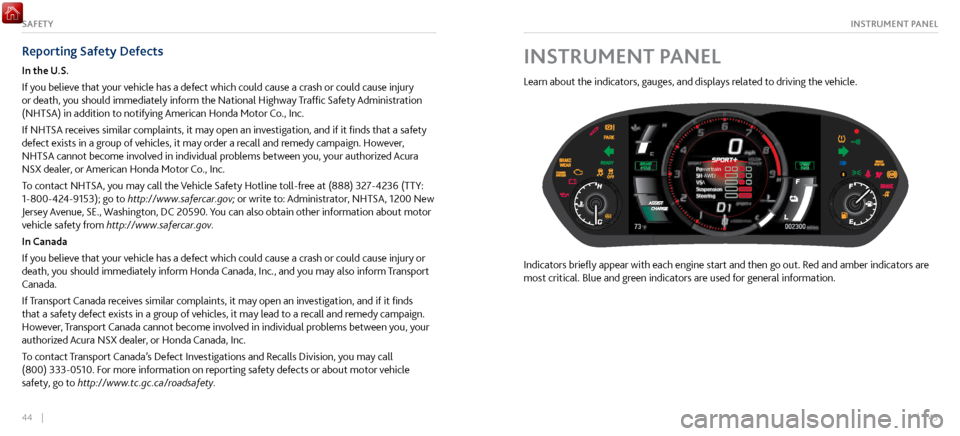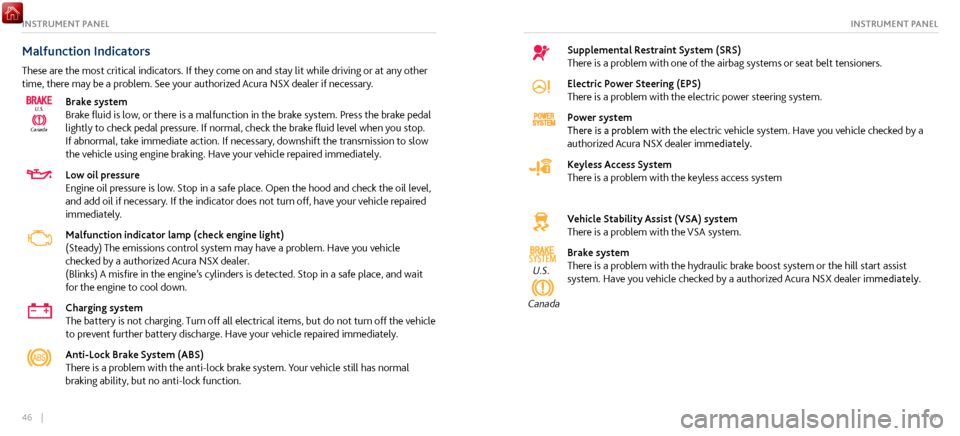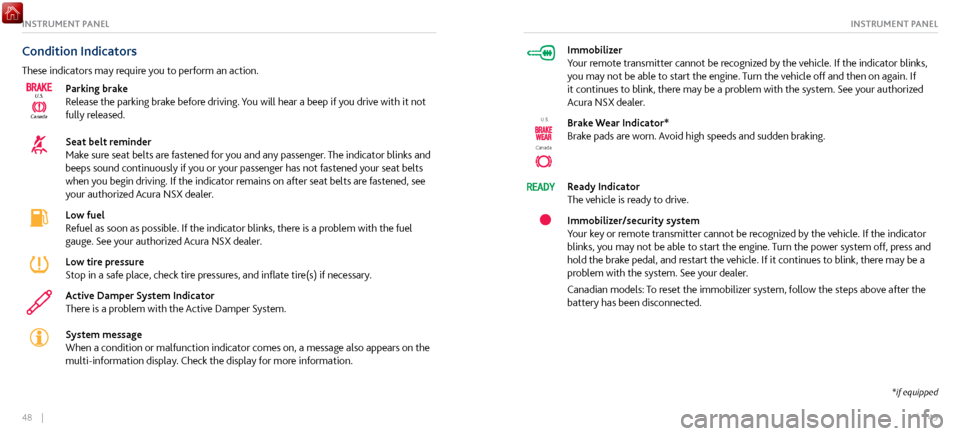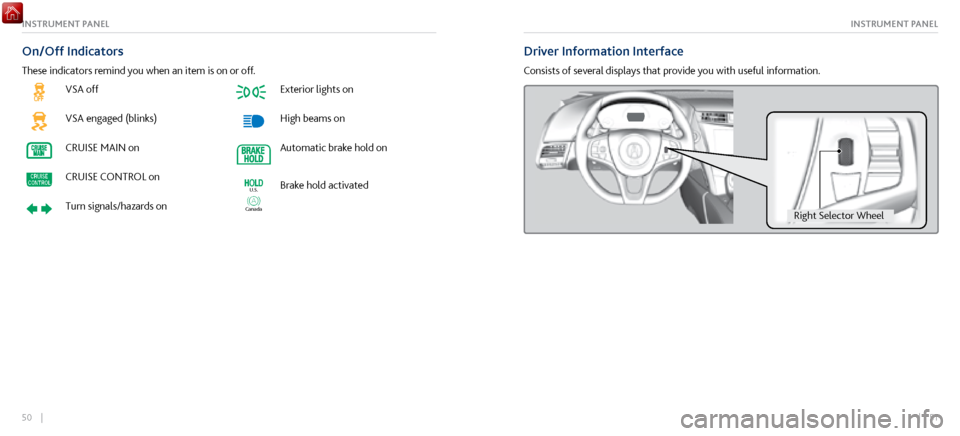Acura NSX 2017 Owner's Manual
Manufacturer: ACURA, Model Year: 2017, Model line: NSX, Model: Acura NSX 2017Pages: 116, PDF Size: 7.19 MB
Page 21 of 116

36 || 37
SAFETYSAFETY
n Protecting Smaller Children
If a child is at least one y
ear old and within the weight range indicated by the child seat
manufacturer, the child should be properly restrained in a firmly secured forward-facing
child seat.
Since this vehicle does not have a back seat, Acura recommends that you do not carry a
child, age 12 or under, as a passenger. This is because placing a forward-facing child seat in
the passenger’s seat can be hazardous, even with advanced front airbags that automatically
turn the passenger’s front airbag off.
If you choose to ignore our warnings and transport a small child in this vehicle, be sure
to move the passenger seat as far to the rear as possible, and follow the instructions and
guidelines in the following pages.
Placing a forward-facing child seat in the front seat can result in serious injury or
death if the front airbag inflates.
If you must place a forward-facing child seat in front, move the vehicle seat as
far back as possible, and properly restrain the child.
WARNING
n Selecting a Child Seat
Important consideration when selecting a child seat
Mak
e sure the child seat meets the following three requirements:
•
The child seat is the correct type and siz
e for the child.
•
The child seat is the correct type
for the seating position.
•
The child seat is compliant with Federal Motor V
ehicle Safety Standard 213 or Canadian
Motor Vehicle Safety Standard 213.
Page 22 of 116

38 || 39
SAFETYSAFETY
n Installing a Child Seat
1.
Move the passenger seat
to the rearmost position.
2.
Place the child seat on the passenger seat
.
3. Route the seat belt through the child seat according to
the seat manufacturer’s instructions, and insert the latch
plate into the buckle. Insert the latch plate fully until it
clicks.
4.
Slowly pull the shoulder
part of the belt all the way out
until it stops. This activates the lockable retractor.
5. Let the seat belt completely wind up into the retractor,
then try to pull it out to make sure the retractor is locked.
If you are able to pull the shoulder belt out, the lockable
retractor is not activated. Pull the seat belt all the way
out, and repeat steps 3–5.
6. Grab the shoulder part of the seat belt near the buckle,
and pull up to remo ve any slack from the lap part of the
belt. When doing this, place your weight on the child seat
and push it into the vehicle seat.
7.
Make sure the child seat is
firmly secured by rocking it
forward and back and side to side; little movement should
be felt.
To deactivate a lockable retractor, release the buckle and allow the seat belt to wind up all
the way.
Page 23 of 116

40 || 41
SAFETYSAFETY
n Adding Security with a Tether
A tether anchorage point is pr ovided behind the passenger seat. A child seat with a tether
can be installed, so long as the base of the child seat is secured using a seat belt.
Using an outer anchor
1.
Route the tether strap through the
head restraint legs.
Make sure the strap is not twisted.
2.
Secure the tether strap hook onto the
anchor.
Tether
PointAnchorage
3. Tighten the tether strap as instructed by the child seat
manufacturer.
Tether Strap Hook
Anchor
n Protecting Larger Children
Since this v
ehicle does not have a back seat, Acura recommends that you do not carry
a child age 12 or under as a passenger. This is because children who have outgrown child
seats are also at risk of being injured or killed by an inflating passenger’s front airbag. If a
larger child must ride in this vehicle, the information below provides guidelines to help you
decide when a given child may ride in this vehicle, and how to properly protect the child.
When a child is too big for a child seat, secure the child in the passenger’s seat using the lap/
shoulder seat belt.
Have the child sit upright and all the way back, then ensure the following:
•
The child’s knees bend comfortably o
ver the edge of the
seat.
•
The shoulder belt crosses between the child’s neck and
arm.
•
The lap part of the seat belt is as low as possible, touching
the
child’s thighs.
•
The child can stay seated for the whole
trip.
Page 24 of 116

42 || 43
SAFETYSAFETY
If a lap/shoulder belt cannot be used properly, position the child in a booster seat in the
passenger’s position. For the child’s safety, check that the child meets the booster seat
manufacturer’s recommendations.
Some U.S. states and Canadian provinces/territories require children to use a booster seat
until they reach a given age or weight (e.g., 6 years or 60 lbs). Be sure to check current laws
in the state or province/territory where you intend to drive.
Allowing a child age 12 or under to sit in the vehicle can result in injury or death
if the passenger’s front airbag inflates.
If a larger child must ride in front, move the vehicle seat as far to the rear as
possible, then have the child sit up properly and wear the seat belt properly,
using a booster seat if needed.
WARNING
Safety Label Locations
Safety labels are in the locations shown. They warn you of potential hazards that can cause
serious injury or death. Read these labels carefully.
Sun Visors
U.S. models
Inverter Coolant Filler
Tank Cap Canadian models
Engine Coolant
Reserve Tank Cap
U.S. models
High Voltage System Components
Canadian models
Dashboard
U.S. models only
49kPa
NEVER OPEN WHEN HO T
Hot coolant will scald yo uN’OUVREZ PAS QUAND CHAUD.NICHT BEI HEISSEM M OTOR ÖFFNEN .49kPa
DANGER
WA RNUNG
If driving at high speeds (over 168mph/270km/h),
adjust cold tire pressure as shown below to avoid
excess heat buildup and sudden tire failure.
DRIVING SPEED TIRE COLD TIRE PRESSUREOVER 168 mph/ 270 km/h FRONT
REAR 260
KPA, 38 PSI
260 KPA, 38 PSI
WARNINGIf driving at high\6 speeds (o ver 16\fmph/2\b0km/h),
adjust cold tire pr\6essure as shown be\6low to avoid
ex cess heat buildup a\6nd sudden tire fai\6lure. Pour conduire à gra\6nde vitesse (plus d\6e 16\f mph /
2\b0 km/h) ajuster la \6pression des pneus\6 à froid, comme
indiqué ci-dessous\6, afn d’éviter l’ac\6cumulation excessive
de chaleur et une d\6éfaillance soudaine \6du pneu.
DRIVING SPEED VITESSE DE CONDUITE COLD TIRE PRESSURE PRESSION DES PNEUS À FROIDTIRE/ PNEU
FRONT/AVANT
REAR/ARRIÈRE260 KPA, 38 PSI
260 KPA, 38 PSI
OVER/ PLUS DE
168 mph/ 270 km/h
WARNINGATTENTION
U.S. models Canadian models
Doorjamb
2DAAAA
Page 25 of 116

44 || 45
INSTRUMENT PANELSAFETY
Reporting Safety Defects
In the U.S.
If you believe that your vehicle has a defect which could cause a crash or could cause injury
or death, you should immediately inform the National Highway Traffic Safety Administration
(NHTSA) in addition to notifying American Honda Motor Co., Inc.
If NHTSA receives similar complaints, it may open an investigation, and if it finds that a safety
defect exists in a group of vehicles, it may order a recall and remedy campaign. However,
NHTSA cannot become involved in individual problems between you, your authorized Acura
NSX dealer, or American Honda Motor Co., Inc.
To contact NHTSA, you may call the Vehicle Safety Hotline toll-free at (888) 327-4236 (TTY:
1-800-424-9153); go to http://www.safercar.gov; or write to: Administrator, NHTSA, 1200 New
Jersey Avenue, SE., Washington, DC 20590. You can also obtain other information about motor
vehicle safety from http://www.safercar.gov.
In Canada
If you believe that your vehicle has a defect which could cause a crash or could cause injury or
death, you should immediately inform Honda Canada, Inc., and you may also inform Transport
Canada.
If Transport Canada receives similar complaints, it may open an investigation, and if it finds
that a safety defect exists in a group of vehicles, it may lead to a recall and remedy campaign.
However, Transport Canada cannot become involved in individual problems between you, your
authorized Acura NSX dealer, or Honda Canada, Inc.
To contact Transport Canada’s Defect Investigations and Recalls Division, you may call
(800) 333-0510. For more information on reporting safety defects or about motor vehicle
safety, go to http://www.tc.gc.ca/roadsafety.INSTRUMENT PANEL
Learn about the indicators, gauges, and displays related to driving the vehicle.
Powe rtrain
SH- AWD
VSA
Suspension
Steering
Indicators briefly appear with each engine start and then go out. Red and amber indicators are
most critical. Blue and green indicators are used for general information.
Page 26 of 116

46 || 47
INSTRUMENT PANELINSTRUMENT PANEL
Malfunction Indicators
These are the most critical indicators. If they come on and stay lit while driving or at any other
time, there may be a problem. See your authorized Acura NSX dealer if necessary.
CanadaU.S.
Brake system
Brake fluid is low, or there is a malfunction in the brake system. Press the brake pedal
lightly to check pedal pressure. If normal, check the brake fluid level when you stop.
If abnormal, take immediate action. If necessary, downshift the transmission to slow
the vehicle using engine braking. Have your vehicle repaired immediately.
Low oil pressure
Engine oil pressure is low. Stop in a safe place. Open the hood and check the oil level,
and add oil if necessary. If the indicator does not turn off, have your vehicle repaired
immediately.
Malfunction indicator lamp (check engine light)
(Steady) The emissions control system may have a problem. Have you vehicle
checked by a authorized Acura NSX dealer.
(Blinks) A
misfire in the engine’s cylinders is
detected. Stop in a safe place, and wait
for the engine to cool down.
Charging system
The battery is not charging. Turn off all electrical items, but do not turn off the vehicle
to prevent further battery discharge. Have your vehicle repaired immediately.
Anti-Lock Brake System (ABS)
There is a problem with the anti-lock brake system. Your vehicle still has normal
braking ability, but no anti-lock function.
Supplemental Restraint System (SRS)
There is a problem with one of the airbag systems or seat belt tensioners.
Electric Power Steering (EPS)
There is a problem with the electric power steering system.
Power system
There is a problem with the electric vehicle system. Have you vehicle checked by a
authorized Acura NSX dealer immediately.
Keyless Access System
There is a problem with the keyless access system
Vehicle Stability Assist (VSA) system
There is a problem with the VSA system.
SYSTEMU.S.
Canada
Brake system
There is a problem with the hydraulic brake boost system or the hill start assist
system. Have you vehicle checked by a authorized Acura NSX dealer immediately.
Page 27 of 116

48 || 49
INSTRUMENT PANELINSTRUMENT PANEL
Condition Indicators
These indicators may require you to perform an action.
CanadaU.S.
Parking brake
Release the parking brake before driving. You will hear a beep if you drive with it not
fully released.
Seat belt reminder
Make sure seat belts are fastened for you and any passenger. The indicator blinks and
beeps sound continuously if you or your passenger has not fastened your seat belts
when you begin driving. If the indicator remains on after seat belts are fastened, see
your authorized Acura NSX dealer.
Low fuel
Refuel as soon as possible. If the indicator blinks, there is a problem with the fuel
gauge. See your authorized Acura NSX dealer.
Low tire pressure
Stop in a safe place, check tire pressures, and inflate tire(s) if necessary.
Active Damper System Indicator
There is a problem with the Active Damper System.
System message
When a condition or malfunction indicator comes on, a message also appears on the
multi-information display. Check the display for more information.
Immobilizer
Your remote transmitter cannot be recognized by the vehicle. If the indicator blinks,
you may not be able to start the engine. Turn the vehicle off and then on again. If
it continues to blink, there may be a problem with the system. See your authorized
Acura NSX dealer.
Canada
U.S.Brake Wear Indicator*
Brake pads are worn. Avoid high speeds and sudden braking.
Ready Indicator
The vehicle is ready to drive.
Immobilizer/security system
Your key or remote transmitter cannot be recognized by the vehicle. If the indicator
blinks, you may not be able to start the engine. Turn the power system off, press and
hold the brake pedal, and restart the vehicle. If it continues to blink, there may be a
problem with the system. See your dealer.
Canadian models: To reset the immobilizer system, follow the steps above after the
battery has been disconnected.
*if equipped
Page 28 of 116

50 || 51
INSTRUMENT PANELINSTRUMENT PANEL
VSA off
VSA engaged (blinks)
CRUISE MAIN on
CRUISE CONTROL on
Turn signals/hazards on
Exterior lights on
High beams on
Automatic brake hold on
Canada
U.S.Brake hold activated
On/Off Indicators
These indicators remind you when an item is on or off.
Driver Information Interface
Consists of several displays that provide you with useful information.
Right Selector Whee l
Page 29 of 116

52 || 53
INSTRUMENT PANELINSTRUMENT PANEL
n Main Displays
Blank Screen
Oil level
check assist Average/instant
fuel economy
Tire pressure
for each tire Range
Engine oil life Elapsed time
Turn-by-turn
directions*
Average speed
Compass
*if equipped
n Lower Displays
Odometer
Outside temperature
Trip B Trip A
Page 30 of 116

54 || 55
VEHICLE CONTROLSVEHICLE CONTROLS
VEHICLE CONTROLS
Learn about the various controls necessary for operating and driving the vehicle.
Using the Remote Transmitter
Lock or unlock the doors and hatch.
LED
Lock button: Press to lock the
doors and hatch. Press again
for audible verification.
Unlock button: Press to
unlock the driver’s door. Press
again to unlock the passenger’s
door.
Leaving the keyless access remote in the vehicle can result in theft or accidental movement of
the vehicle. Always take the key with you whenever you leave the vehicle unattended.
NOTICE
Keyless Access System
When you carry the remote transmitter (for example, in a pocket or purse) and it is outside the
vehicle and within range (about 32 inches or 80 cm), you can lock or unlock the doors and hatch
without handling the transmitter.
n
Unlocking/Locking the Doors
To unlock:
The door handle will pop out if both doors are
closed. If the handle fails to pop out, push on its front side.
To lock: Press the door lock button on either door handle
when the vehicle is off. If the remote transmitter is inside the
vehicle, the doors will not lock.
n Auto Pop-Out Main Switch
To disable the auto
pop-out function: Use the switch in the
glove compartment.
Main Switc h
ON
OFF